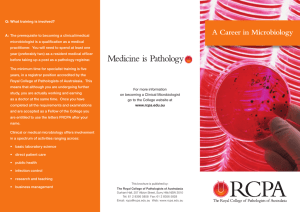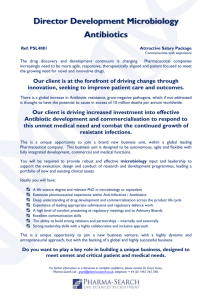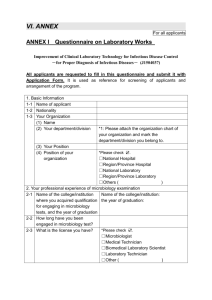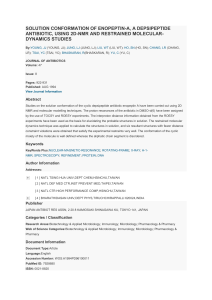Germ Warfare
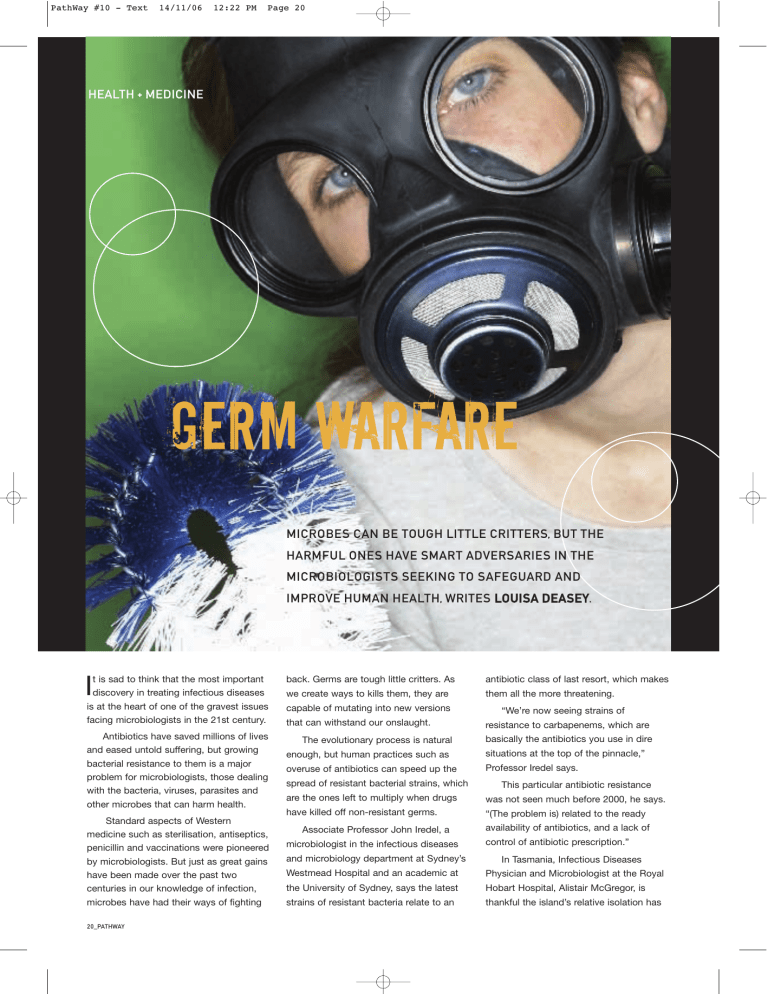
PathWay #10 - Text 14/11/06 12:22 PM Page 20
HEALTH + MEDICINE
Germ Warfare
MICROBES CAN BE TOUGH LITTLE CRITTERS, BUT THE
HARMFUL ONES HAVE SMART ADVERSARIES IN THE
MICROBIOLOGISTS SEEKING TO SAFEGUARD AND
IMPROVE HUMAN HEALTH, WRITES L OU A D AS Y.
I t is sad to think that the most important discovery in treating infectious diseases is at the heart of one of the gravest issues facing microbiologists in the 21st century.
Antibiotics have saved millions of lives and eased untold suffering, but growing bacterial resistance to them is a major problem for microbiologists, those dealing with the bacteria, viruses, parasites and other microbes that can harm health.
Standard aspects of Western medicine such as sterilisation, antiseptics, penicillin and vaccinations were pioneered by microbiologists. But just as great gains have been made over the past two centuries in our knowledge of infection, microbes have had their ways of fighting back. Germs are tough little critters. As we create ways to kills them, they are capable of mutating into new versions that can withstand our onslaught.
The evolutionary process is natural enough, but human practices such as overuse of antibiotics can speed up the spread of resistant bacterial strains, which are the ones left to multiply when drugs have killed off non-resistant germs.
Associate Professor John Iredel, a microbiologist in the infectious diseases and microbiology department at Sydney’s
Westmead Hospital and an academic at the University of Sydney, says the latest strains of resistant bacteria relate to an antibiotic class of last resort, which makes them all the more threatening.
“We’re now seeing strains of resistance to carbapenems, which are basically the antibiotics you use in dire situations at the top of the pinnacle,”
Professor Iredel says.
This particular antibiotic resistance was not seen much before 2000, he says.
“(The problem is) related to the ready availability of antibiotics, and a lack of control of antibiotic prescription.”
In Tasmania, Infectious Diseases
Physician and Microbiologist at the Royal
Hobart Hospital, Alistair McGregor, is thankful the island’s relative isolation has
20_PATHWAY
PathWay #10 - Text 14/11/06 12:22 PM Page 21
“Pathology is about good surveillance and diagnosis which allows the opportunity for early intervention and, ideally, prevention. If we can prevent patients becoming infected with antibiotic resistant bugs then we will save lives, avoidable complications and money.”
helped to prevent the widespread dissemination of antibiotic resistant bugs.
“Tasmania has been lucky so far, but it is inevitable that we will start to see the same sort of antibiotic resistance issues that are now appearing on the mainland.
We now have a brief window of opportunity to take preventative measures and I believe that if we are able to increase our infection control procedures and better monitor and control antibiotic prescribing now we may be able to reduce the impact of these bugs over time.”
“Pathology is about good surveillance and diagnosis which allows the opportunity for early intervention and, ideally, prevention. If we can prevent patients becoming infected with antibiotic resistant bugs then we will save lives, avoidable complications and money.”
Despite the difficulties, antibiotics are still a vital part of health care and for most microbiologists working on the “front line”, a huge part of the job is consulting on antibiotic use, a task all the tougher in intensive care, where Professor Iredel works, “because you’re ‘flying blind’ due to the time constraints”.
This creates one of the biggest challenges for microbiologists working in clinical pathology – keeping a patient alive can often mean killing off everything with the strongest antibiotic that can be used.
This means they can’t grow certain organisms separately and thus lose valuable scientific research. It has also contributed to new forms of antibiotic resistant bacteria appearing in hospitals.
Professor Iredel says the latest partnerships with bio-tech companies have meant the development of some essential rapid-diagnostic tools. Where most microbiology is “hands on” – i.e.
patient swab samples are sent to a lab where the microbiologist grows certain organisms and identifies the pathogen – molecular advances have sped up disease diagnosis in some cases.
Most recently and successfully, chlamydia can now be diagnosed in a matter of days not weeks, thanks to automation and molecular technology.
Dr Arthur Morris, a clinical microbiologist with Diagnostic Medlab in
Auckland, New Zealand, says using automation to try to detect the DNA of the pathogen suits some diagnoses but not others.
“Molecular testing can be quicker, which is always good in terms of diagnosis,” he says. “For example, tuberculosis can take up to six weeks to grow in a lab, but with molecular testing it can be found in just a few days.
Chlamydia is also difficult to grow, so the vast majority of chlamydia tests are molecular.”
The new technology is a long way from taking over though, and the microbiologist’s skills of careful investigation and assessment are still very much required.
Dr Morris says he was captivated by microbiology when he studied it as a fill-in subject as part of a medical degree.
“It’s a living science. The story of an organism evolves over several days and you have to coax and create the right environment for growth. It’s like a mysterious detective story where you need to look for certain signs and clues … many don’t become apparent until you’re further down the line.”
Communication skills are an important element of the job, he says.
“As a microbiologist, you can spend your days speaking with everyone from the patient to the lab staff to the doctors, midwives and community specialists.”
With an emphasis on investigation, good microbiologists spend a lot of time asking questions and also educating others on what to look for.
Dr Morris says the process begins by educating the clinician on how to take a valid specimen from the patient and extends to getting an accurate patient history, which may involve questioning relatives or friends.
“Certain key information can mean the difference between studying one of millions of organisms. You can never have too much information in a clinical sense.
“A patient presenting to her GP complaining of sweating, fever and headache could have one of thousands of bacteria. The first challenge is educating the clinician on how to get a good specimen to send to the lab.
“If the patient reveals they have recently travelled to a certain country, that can narrow down the hunt even further.
It’s important to ask plenty of questions, because the patient will often not realise
Associate Professor John Iredel, a microbiologist in the infectious diseases and microbiology department at Sydney’s Westmead Hospital
PHOTO: JAMES ALCOCK
PATHWAY_21
PathWay #10 - Text 14/11/06 12:22 PM Page 22 the relevance of something to their diagnosis.”
Dr Joan Faoagali, a clinical microbiologist at Royal Brisbane Hospital, says the excitement of working with living organisms that can alter rapidly is what led her into the field. “You never know what you’re going to find. Every day is
Dr Joan Faoagali, a clinical microbiologist at Royal
Brisbane Hospital
PHOTO: PORFYRI PHOTOGRAPHY different, as the organism changes from one day to the next.”
Dr Faoagali says surveillance is the cornerstone of microbiology.
Fluid swabs – from a patient’s tissue, the spine or an ulcer – are monitored and studied, much like the evidence in a legal trial, to form the threads of the most likely story. Dr Faoagali says there can often be disagreement in the lab about what an organism appears to be, but it is in this grey area that the ‘‘art’’ of microbiology applies.
She says it is often a case of searching for that vital piece of information that could change the diagnosis.
Though you might not relate a microbiologist to the emergency department of a hospital, the passion, as
Dr Faoagali says, for knowing “which germs and parasites to put in jail”, means the difference between life and death for many patients with infections.
Dr Faoagali says this is one of the most satisfying parts of her job – through successful lab research by the microbiologist, the clinician can have a swift and accurate diagnosis.
“I feel embarrassed to say it, but I feel so lucky to come in every day to a job I really enjoy and that is so interesting,” she says.
GPs NOTE: This article is available for patients at http://pathway.rcpa.edu.au
22_PATHWAY
THE
MICROBIOLOGY
PATHWAY
There are a number of different career paths available for those interested in Microbiology.
M ED AL CR OB LO GIIS T
Medical microbiologists are specialist pathologists who supervise specimens coming into the lab for infection diagnosis. They ensure appropriate methods are followed and that the answers are correct and meaningful.
Ultimately they give direct advice on the management of the disease. They are also involved in public health issues such as infection control, immunisation and how to make food and water safer.
To become a medical microbiologist you must first complete a medical degree and then undertake further training with the Royal College of
Pathologists of Australasia. The College accepts applications from registered medical practitioners with a minimum of one year's post-graduate experience.
pathologist. Applicants must be employed in an accredited laboratory before seeking registration with the
College. Pathology training takes a minimum of five years and includes a series of examinations.
For more information visit the RCPA website at www.rcpa.edu.au
MIIC RO BIIO LO Y S CIIE TIIS S A D
L AB AT OR TE CH CIIA S
Microbiology Scientists undertake a 3 to
4 year undergraduate degree in science through various Universities. Many scientists undertake further training such
Masters and PHD degrees after their basic degree. Laboratory Technicians require to undertake at least a Diploma in Applied Science,
For information for training as a medical laboratory scientist visit www.aims.org.au
R ES AR H A ST AN
Research assistants support researchers by providing technical assistance in the collection, processing, and co-ordination of data, samples, and specimens. Your work will involve conducting routine tests, experiments and procedures relevant to the field of study. You’ll need at least a Bachelor of
Science.
